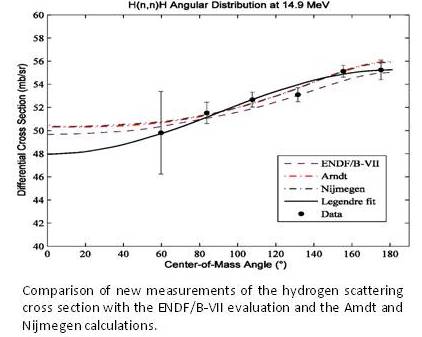| * |
|
Neutron Cross Section Standards
Summary:NIST continues to be deeply involved with measurements and evaluations of neutron cross section standards. NIST maintains a limited experimental effort focused on improvements to the database of the standards. Description:Measurements have been completed at Ohio University of the important hydrogen scattering angular distribution standard at 14.9 MeV neutron energy in an NIST-Ohio University-LANL collaborative experiment. This work was initiated as a result of problems that became apparent in evaluations of this cross section. The work has been published in Phys. Rev. C82 014001 (2010). These data were obtained by detecting the scattered protons from scattering of neutrons on hydrogen. The large uncertainty for our point near 60 degrees in the CMS is a result of significant background at smaller angles using the proton detection method. A new experiment is now underway in which the scattered neutrons are being detected. With this method measurements can be made at smaller CMS angles with smaller uncertainties. Only one experiment has been done (in 1967) at small CMS angles and that experiment indicates higher cross sections near zero degrees in the CMS. Also some improvements to measurements at 10 MeV by this collaboration were published in Phys. Rev. C82 039901 (2010). Plans have been made to measure this cross section using a Time Projection Chamber which will provide higher counting rates than are possible with other methods.
A major effort was the recently completed international evaluation of the neutron cross section standards. This evaluation was supported in part by an International Atomic Energy Agency (IAEA) Coordinated Research Project, a Nuclear Energy Agency Nuclear Science Committee Subgroup and a U.S. Cross Section Evaluation Working Group Task Force. NIST played a major leadership role in each of these activities. A more than 100 page detailed journal paper on this work was published in Nuclear Data Sheets 110 3215 (2009). Contributors to the evaluation were from Austria, Belgium, China, Germany, Japan, Russia, South Korea, and the U.S.A. The cross sections for the H(n,n), 6Li(n,t), 10B(n,α), 10B(n,α1γ), Au(n,γ), 235U(n,f), and 238U(n,f) standards were obtained from this evaluation. These standards were accepted for use in the ENDF/B-VII.0 evaluation. In an effort to continually update the standards so they will be current for use by data libraries, NIST worked with the IAEA to form a nuclear data development project, "maintenance of the neutron cross section standards". This development project provides some resources for continually improving and updating the standards. Also codes used for the evaluation process will be maintained. The second Consultants' Meeting of this project, chaired by the NIST representative, was held in Vienna in October 2010. At the meeting the cross section database was discussed and updated; further work was done to help decide what inelastic scattering cross section should be used as a reference cross section; an investigation was continued on an additional energy region where gold capture could be a reference cross section; and database improvements for updates to evaluations of the 252Cf spontaneous fission neutron spectrum and the 235U thermal neutron-induced fission neutron spectrum were investigated with the objective of reducing uncertainties at the highest and lowest energies. Many of the standards are used directly in neutron dosimetry for fluence determination. Also, almost all measurements of other dosimetry cross sections have been made relative to neutron cross section standards. The dosimetry community requires covariances for the full energy range from 10-5 eV to 20 MeV for their evaluations. Since the standards evaluation does not cover that entire region, it at first appeared that our evaluation would not be used by them. This led to additional work which provided covariances in the regions not included in our evaluation, so now the very well defined covariances obtained from the standards evaluation process are included in the new ENDF/B-VII mod, ENDF/B-VII.1. Impact: Improved values for the standard neutron cross sections lead to similar improvements both in fundamental measurements such as absolute determination of neutron fluence and in applications using neutrons including neutron shielding for personnel protection, design of new detectors for nuclear monitoring and homeland security, and design of next-generation nuclear reactors and isotope production facilities. |
Lead Organizational Unit:pmlStaff: |

 Data from a number of NIST collaborations focused on other applications have produced measurements useful for the standards program.
Data from a number of NIST collaborations focused on other applications have produced measurements useful for the standards program.